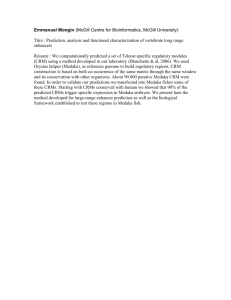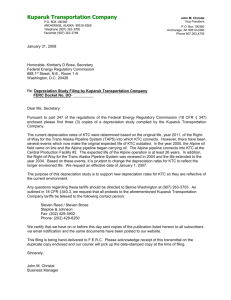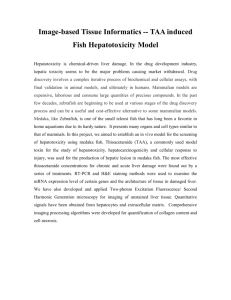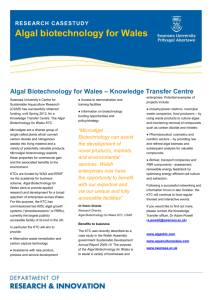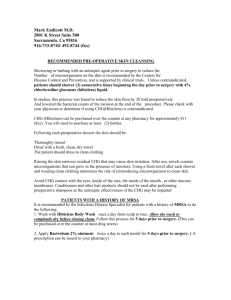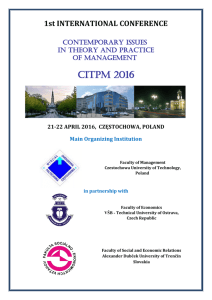Responses of the Medaka HPG Axis
advertisement
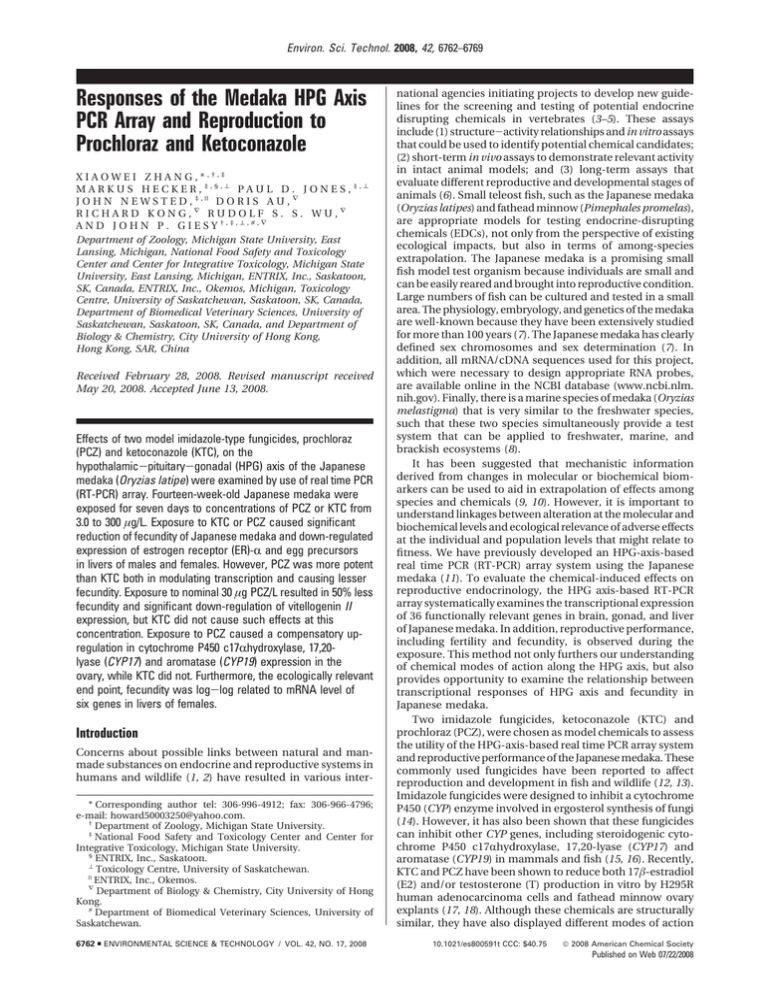
Environ. Sci. Technol. 2008, 42, 6762–6769 Responses of the Medaka HPG Axis PCR Array and Reproduction to Prochloraz and Ketoconazole X I A O W E I Z H A N G , * ,†,‡ M A R K U S H E C K E R , ‡,§,⊥ P A U L D . J O N E S , ‡,⊥ J O H N N E W S T E D , ‡,| D O R I S A U , ∇ RICHARD KONG,∇ RUDOLF S. S. WU,∇ A N D J O H N P . G I E S Y †,‡,⊥,#,∇ Department of Zoology, Michigan State University, East Lansing, Michigan, National Food Safety and Toxicology Center and Center for Integrative Toxicology, Michigan State University, East Lansing, Michigan, ENTRIX, Inc., Saskatoon, SK, Canada, ENTRIX, Inc., Okemos, Michigan, Toxicology Centre, University of Saskatchewan, Saskatoon, SK, Canada, Department of Biomedical Veterinary Sciences, University of Saskatchewan, Saskatoon, SK, Canada, and Department of Biology & Chemistry, City University of Hong Kong, Hong Kong, SAR, China Received February 28, 2008. Revised manuscript received May 20, 2008. Accepted June 13, 2008. Effects of two model imidazole-type fungicides, prochloraz (PCZ) and ketoconazole (KTC), on the hypothalamic-pituitary-gonadal (HPG) axis of the Japanese medaka (Oryzias latipe) were examined by use of real time PCR (RT-PCR) array. Fourteen-week-old Japanese medaka were exposed for seven days to concentrations of PCZ or KTC from 3.0 to 300 µg/L. Exposure to KTC or PCZ caused significant reduction of fecundity of Japanese medaka and down-regulated expression of estrogen receptor (ER)-R and egg precursors in livers of males and females. However, PCZ was more potent than KTC both in modulating transcription and causing lesser fecundity. Exposure to nominal 30 µg PCZ/L resulted in 50% less fecundity and significant down-regulation of vitellogenin II expression, but KTC did not cause such effects at this concentration. Exposure to PCZ caused a compensatory upregulation in cytochrome P450 c17Rhydroxylase, 17,20lyase (CYP17) and aromatase (CYP19) expression in the ovary, while KTC did not. Furthermore, the ecologically relevant end point, fecundity was log-log related to mRNA level of six genes in livers of females. Introduction Concerns about possible links between natural and manmade substances on endocrine and reproductive systems in humans and wildlife (1, 2) have resulted in various inter* Corresponding author tel: 306-996-4912; fax: 306-966-4796; e-mail: howard50003250@yahoo.com. † Department of Zoology, Michigan State University. ‡ National Food Safety and Toxicology Center and Center for Integrative Toxicology, Michigan State University. § ENTRIX, Inc., Saskatoon. ⊥ Toxicology Centre, University of Saskatchewan. | ENTRIX, Inc., Okemos. ∇ Department of Biology & Chemistry, City University of Hong Kong. # Department of Biomedical Veterinary Sciences, University of Saskatchewan. 6762 9 ENVIRONMENTAL SCIENCE & TECHNOLOGY / VOL. 42, NO. 17, 2008 national agencies initiating projects to develop new guidelines for the screening and testing of potential endocrine disrupting chemicals in vertebrates (3–5). These assays include (1) structure-activity relationships and in vitro assays that could be used to identify potential chemical candidates; (2) short-term in vivo assays to demonstrate relevant activity in intact animal models; and (3) long-term assays that evaluate different reproductive and developmental stages of animals (6). Small teleost fish, such as the Japanese medaka (Oryzias latipes) and fathead minnow (Pimephales promelas), are appropriate models for testing endocrine-disrupting chemicals (EDCs), not only from the perspective of existing ecological impacts, but also in terms of among-species extrapolation. The Japanese medaka is a promising small fish model test organism because individuals are small and can be easily reared and brought into reproductive condition. Large numbers of fish can be cultured and tested in a small area. The physiology, embryology, and genetics of the medaka are well-known because they have been extensively studied for more than 100 years (7). The Japanese medaka has clearly defined sex chromosomes and sex determination (7). In addition, all mRNA/cDNA sequences used for this project, which were necessary to design appropriate RNA probes, are available online in the NCBI database (www.ncbi.nlm. nih.gov). Finally, there is a marine species of medaka (Oryzias melastigma) that is very similar to the freshwater species, such that these two species simultaneously provide a test system that can be applied to freshwater, marine, and brackish ecosystems (8). It has been suggested that mechanistic information derived from changes in molecular or biochemical biomarkers can be used to aid in extrapolation of effects among species and chemicals (9, 10). However, it is important to understand linkages between alteration at the molecular and biochemical levels and ecological relevance of adverse effects at the individual and population levels that might relate to fitness. We have previously developed an HPG-axis-based real time PCR (RT-PCR) array system using the Japanese medaka (11). To evaluate the chemical-induced effects on reproductive endocrinology, the HPG axis-based RT-PCR array systematically examines the transcriptional expression of 36 functionally relevant genes in brain, gonad, and liver of Japanese medaka. In addition, reproductive performance, including fertility and fecundity, is observed during the exposure. This method not only furthers our understanding of chemical modes of action along the HPG axis, but also provides opportunity to examine the relationship between transcriptional responses of HPG axis and fecundity in Japanese medaka. Two imidazole fungicides, ketoconazole (KTC) and prochloraz (PCZ), were chosen as model chemicals to assess the utility of the HPG-axis-based real time PCR array system and reproductive performance of the Japanese medaka. These commonly used fungicides have been reported to affect reproduction and development in fish and wildlife (12, 13). Imidazole fungicides were designed to inhibit a cytochrome P450 (CYP) enzyme involved in ergosterol synthesis of fungi (14). However, it has also been shown that these fungicides can inhibit other CYP genes, including steroidogenic cytochrome P450 c17Rhydroxylase, 17,20-lyase (CYP17) and aromatase (CYP19) in mammals and fish (15, 16). Recently, KTC and PCZ have been shown to reduce both 17β-estradiol (E2) and/or testosterone (T) production in vitro by H295R human adenocarcinoma cells and fathead minnow ovary explants (17, 18). Although these chemicals are structurally similar, they have also displayed different modes of action 10.1021/es800591t CCC: $40.75 2008 American Chemical Society Published on Web 07/22/2008 (MOA) on other biological pathways within the reproductive tract and the HPG axis. For example, PCZ, but not KTC, has been identified as an androgen receptor (AR) antagonist in rat and fathead minnow (19, 20). The objective of this study was to evaluate the effects of the two fungicides, KTC and PCZ, during a short-term exposure, on the transcriptional profiles of the key pathways within the medaka HPG axis. It was hypothesized that the observed different transcriptional responses by the two chemicals are due to different modes of action on the HPG axis of Japanese medaka. In the present study, the quantitative relationship between hepatic transcriptional responses and egg reproduction of medaka was investigated during 7-d laboratory exposures. Materials and Methods Animals and Exposure. Male and female wild-type O. latipes were maintained in flow-through tanks in conditions that facilitated breeding (23-24 °C; 16:8 light/dark cycle) using the protocol previously described (11, 21, 22). Before exposure, 14-wk-old Japanese medaka were acclimated in 10-L tanks filled with 6 L of carbon-filtered water for a period of 7 d prior to initiation of experiments. Each tank contained 5 male and 5 female fish as determined by secondary sexual characteristics of the fins. One half of the water in each tank (3 L) was replaced daily with fresh carbon-filtered water. Ketoconazole (KTC) and prochloraz (PCZ) were obtained from Sigma-Aldrich (St. Louis, MO) and dissolved in the least amount of dimethyl sulfoxide (DMSO; Sigma-Aldrich, St. Louis, MO) possible to produce a stock solution of known concentration. After the acclimation period, fish were exposed to vehicle control (DMSO with a final concentration of 1:10,000 v/v water), 3.0, 30, and 300 µg KTC/L, or 3.0, 30, and 300 µg PCZ/L in a 7-d static renewal exposure scenario. The DMSO concentration was constant among all the PCZ and KTC treatment groups. Exposures started at 8:30 a.m. and one-half of the water in each tank (3 L) was replaced with fresh carbon-filtered water dosed with the appropriate amount of chemicals at 8:30 a.m. each day during exposure. Eggs produced during the previous 24 h period were counted and recorded before the replacement of water. No mortalities were observed at any treatment during the exposure period. There were two replicate tanks for each time point of PCZ exposure and one replicate tank for each of the seven time points of KTC exposure. For gene expression analysis, 4-6 males and females were randomly sampled from the two replicate tanks of each PCZ treatment at each time point. All fish in KTC exposure were examined. Fish were euthanized in Tricaine S solution (Western Chemical, Ferndale, WA), and total weight and snout-vent length were recorded for each fish. Samples of brain, liver, and gonads were collected and preserved in RNAlater storage solution (Sigma, St. Louis, MO) at -20 °C until analysis of gene expression. The RNA samples isolated from each fish were independently analyzed. Masses of body, brain, liver, and gonad of each fish were recorded. Indices including hepatic-somatic index (HSI), gonadal-somatic index (GSI), and brain-somatic index (BSI) were calculated. Real Time-PCR Array Measurement. Processing of tissues followed the previously reported protocol (11). Briefly, total RNA was individually extracted from tissues according to the manufacture’s protocol with Agilent Total RNA Isolation Mini Kit (Agilent Technologies, Palo Alto, CA). First-strand cDNA synthesis was performed using Superscript III firststrand synthesis SuperMix and Oligo-dT primers (Invitrogen, Carlsbad, CA). The measurement of gene expression in brain, liver, and gonad tissues was conducted using the medaka HPG axis PCR array system described previously (11). Briefly, real-time Q-RT-PCR was performed by using a 384-well ABI 7900 high-throughput real time PCR System (Applied Bio- systems, Foster City, CA). PCR reaction mixtures for 100 reactions contained 500 µL of SYBR Green master mix (Applied Biosystems, Foster City, CA), 2 µL of 10 µM sense/ antisense gene-specific primers, and 380 µL of nuclease-free distilled water (Invitrogen). A final reaction volume of 10 µL was made with 2 µL of diluted cDNA and 8 µL of PCR reaction mixtures using a Biomek automation system (Beckman Coulter, Inc., Fullerton, CA). Quantification of target gene expression was based on comparative cycle threshold (Ct) method with adjustment of PCR efficiency according to a previous study (23). The average ct value of beta-Actin, RPL7, and 16s was used as reference for the expression calculation of target genes in brain and gonad tissues, and the average ct value of 16S rRNA and RPL-7 was used as reference genes in liver tissue. Statistical Analyses. Statistical analyses were conducted using the R project language (http://www.r-project.org/). Fecundity data were analyzed using analysis of variance (ANOVA), in which the effects of time (day) and chemicals on the daily recorded egg production were examined. Levels of expression of genes in tissues were expressed as the fold change relative to the average value of the vehicle control. Prior to conducting statistical comparisons of gene expression value Bartlett Tests were performed to check homogeneity of variances of data. Normality of the distributions of data was evaluated by Shapiro-Wilk’s test. If necessary, data were log-transformed to approximate normality. Differences of relative gene expressions among treatments were evaluated by ANOVA followed by pairwise t tests. Differences with p < 0.01 were considered to be significant. Results Fecundity. Statistically significant differences were observed on the cumulative egg productions by medaka from different treatments (Figure 1). Both PCZ exposure and KTC exposure induced concentration-dependent decrease of fish fecundity in a time-dependent manner. There was no statistically significant difference between cumulative egg production by fish exposed to 3.0 µg PCZ/L and that of unexposed fish. However, exposure to 30 and 300 µg PCZ/L resulted in significantly less fecundities of 50% and 18%, respectively, relative to that of medaka exposed to the vehicle control. The proportions of eggs produced, relative to the solvent control were 89%, 84.2%, and 20.3% when medaka were exposed to 3.0, 30, or 300 µg KTC/L, respectively. Only exposure to 300 µg KTC/L resulted in statistically significant less fecundity. None of the concentrations of either KTC or PCZ caused any statistically significant effects on any of the body indices, HSI, GSI, or BSI. Transcriptional Response to Prochloraz. Sex- and organspecific transcriptional patterns were observed in the PCZ treated medaka fish. There was a statistically significant, concentration-dependent down-regulation of hepatic genes including ER-R, VTG I, VTG II, choriogenin L (CHGL), choriogenin H (CHG H) and CHG Hminor (CHG HM) in females exposed to PCZ (Table 1, Figure 2). Exposure of females to 300 µg PCZ /L caused the greatest (54-fold) less ER-R expression, relative to that of the vehicle control. Alternatively, responses of genes in the livers of males exposed to PCZ were more variable and of lesser magnitude than that of the females. Slight up-regulation of VTG I and CHG H transcript were observed in liver of males exposed to 3.0 µg PCZ/L. However, exposure to 300 µg PCZ/L significantly down-regulated expression of VTG II, CHG H, and CHG HM in livers of males. In contrast, exposure of males to 300 µg PCZ/L caused a statistically significant and concentration dependent up-regulation in expression of ER-β in livers. Exposure to PCZ caused differences in transcriptional responses of genes in both ovaries and testis. There were VOL. 42, NO. 17, 2008 / ENVIRONMENTAL SCIENCE & TECHNOLOGY 9 6763 FIGURE 1. Cumulative fecundity of Japanese medaka exposed to prochloraz (PCZ) or ketoconazole (KTC) at the end of each day in the 7 d exposure. In the PCZ exposure, values are average of the cumulative number of eggs in two replicate tanks at each time point. In the KTC exposure, there was one tank at each of the 7 time points. Asterisks indicate a significant different from control group: *, p < 0.05. TABLE 1. Transcriptional Response Profiles of HPG Axis Pathways in Medaka Fish Exposed to Prochloraz (PCZ); Gene Expression is Expressed As the Fold Change Compared to That of the Corresponding Vehicle Controlsa,b female tissue gene male 3 µg/L 30 µg/L 300 µg/L brain ER-R ER-β AR-R NPY cGnRH II mfGnRH sGnRH GnRH RI GnRH RII GnRH RIII CYP19B -1.06 1.15 1.03 -1.58 1.96* -1.19 -1.8* 1.07 -1.29 -1.17 -1.09 1.79 1.05 -1.22 -1.2 -1.35 1.85 -1.38 1.63 -1.49** -1.27 -1.05 -1.26 1.15 -1.08 -1.42 1.35 -1.69 -1.26 -1.46 -1.31 -1.53* -2.69** gonad ER-R ER-β AR-R FSHR LHR HDLR LDLR HMGR StAR CYP11A CYP11B CYP17 CYP19A CYP3A 3βHSD Inhibin A ActivinBA ActivinBB -1.26 -1.39 -1.29 -1.19 -1.74 -1.05 1.01 -1.76 -1.36 -1.04 -1.74 1.19 -1.39 -1.02 -1.67 1.07 -2.12 -1.09 -1.5 -1.68 1.01 1.1 -1.46 -1.02 1.05 -2.39 -1.0 1.34 -2.57 1.8* 2.46** -1.4 -1.01 1.11 -3.09* -1.2 -1.09 -2.26* 1.02 1.39 1.01 -2.74* 1.04 -3.73* -1.04 1.33 -4.0* 3.46** 2.38** -1.86 1.42 1.28 -8.33* -1.03 liver ER-R ER-β AR-R VTG I VTG II CHG H CHG HM CHG L Annexin.max2 -1.0 1.32 1.3 1.07 -1.37* 1.07 -1.32 -1.01 1.6 -1.27 2 1.69 -2.07 -3.35** -1.93 -2.62** -1.78 1.8 -54.5** 2.02 -1.78 -58.7** -4000** -113** -877** -1020** 2.21* a Animal replicate (n ) 4-6). b 9 30 µg/L 300 µg/L 1.78 -1.07 1.16 -1.06 1.22 1.7 1.32 1.65 1.14 1.21 -1.19 2.97* 1.17 1.14 1.03 -1.1 3.66* 1.46 2.6 1.02 1.17 -1.61** 1.06 -1.17 1.13 -1.35 1.06 1.71 -1.02 1.47 1.09 -1.07 -2.76** 1.25 1.25 1.3 2.12 1.54 1.59 1.25 -1.19 1.53 1.62 1.65 1.51 2.48* -3.64 1.41 1.53 2.57* 1.66 -1.02 1.06 1.14 1.43 1.31 1.33 1.53* -1.5 -1.03 1.46 1.75 1.58 2.76 -2.83 1.29 -1.05 4.41** 1.53 1.22 1.35 1.81** 1.34 -1.11 1.12 1.28 -1.62* 1.4 2.66* 3.02** 3.48** 1.84 -2.34 2.39** 1.22 2.04 1.09 -1.09 1.41 -1.11 2.85 1.12 2.32* 1.3 2.78 -1.32 -1.72 1.88** -1.33 -4.37 -9.11* -5.8* -10.5** -4.87* 1.02 1.34 1.2 1.01 3.66* 2.72 3.49** 1.55 4.27 1.01 *, p < 0.01; **, p < 0.001. no statistically significant differences between levels of transcription in ovaries from fish exposed to 3.0 µg PCZ/L and that of the vehicle control. Concentration-dependent up-regulation of CYP17 and CYP19A was observed in 6764 3 µg/L ENVIRONMENTAL SCIENCE & TECHNOLOGY / VOL. 42, NO. 17, 2008 ovaries of females exposed to PCZ with the significant differences observed in females exposed to 300 µg PCZ/L. Conversely, expression of ovarian activin BA was inversely proportional to PCZ exposure concentration. PCZ exposure FIGURE 2. Striped view of concentration-dependent response profile in PCZ exposure of female Japanese medaka. Gene expression data from medaka treated by 3.0, 30, and 300 µg PCZ/L are shown as striped color sets on the selected endocrine pathways along the medaka HPG axis. The legend listed in the upper right corner of the graph describes the order of the three PCZ concentrations and the eight colors designating different fold thresholds. LH, luteinizing hormone; FSH, follicle-stimulating hormone; E2, 17β-estradiol; T, testosterone; HDL, high-density lipoproteins; LDL, low-density lipoproteins. caused concentration-dependent up-regulation expression of ER-R, VTG I, VTG II, CHG L, CHG H, and CHG HM in liver of AR-R and steroidogenic CYP11B, CYP11A, CYP17, and of females (Table 2) (SI Figure 1). Choriogenin H and CHG 3β HSD in testes. Expression to 30 µg PCZ/L caused HM were decreased, while ER-R was increased by 6.2-fold statistically significant up-regulation of Activin BA in liver in livers of males exposed to 300 µg KTC/L. KTC caused of males. reduction of hepatic AR-R mRNA and an increase in annexin Exposure to PCZ caused only minor effects in the brains max2 transcript in both males and females exposed to 300 of medaka. PCZ caused dose-dependent down-regulation of µg KTC/L. brain-type aromatase (CYP19B) in both male and female after Changes in opposite directions were observed in testis 7 d of exposure. GnRH RII and GnRH RIII were also downand ovaries of KTC-exposed Japanese medaka. KTC exposure regulated in brains of PCZ exposed females, but not in males. caused concentration-dependent down-regulation of ovarian Transcriptional Response to Ketoconazole. Exposure to receptors ER-β, AR-R, and LHR, steroidogenic genes HMGR, KTC altered the transcriptional expression of E2 responsive StAR, CYP11A, and CYP11B, and activin subunits activin BA genes in livers of males and females. Consistent with the and activin BB. Conversely, exposure to 300 µg KTC/L caused lesser fecundity, exposure to 300 µg KTC/L caused less mRNA a statistically significantly up-regulated the ER-β, LHR, and VOL. 42, NO. 17, 2008 / ENVIRONMENTAL SCIENCE & TECHNOLOGY 9 6765 LDLR genes in testes. In addition, transcription of CYP19A (aromastase) and activin BA genes was up-regulated in a dose-dependent manner, with significant alteration caused by exposure to 300 µg KTC/L. KTC caused down-regulation of gene expression in brains of both males and females. Concentrations of GnRH RII and GnRH RIII were both less in brains of females exposed to 300 µg KTC/L. CYP19B was slightly down-regulated (-1.7-fold change; p ) 0.022) in brains of males exposed to 300 µg KTC/L. Correlation between Fecundity and Hepatic Gene Expression Profiles. To investigate the relationship between fecundity and hepatic gene expression profiles in females, the results for KTC and PCZ reported here were combined with previously reported data for TRB and FAD (11, 22) (SI Figure 2). Six hepatic genes displayed similar changes across different treatment, including ER-R, VTG I, VTG II, CHG L, CHG H, and CHG HM. Principal component analysis on the transcript expression of the selected hepatic genes among chemical treatments confirmed that expression of these genes was correlated, with the first principle component (PC1) explaining 96.3% of the variance among the six genes (SI Figure 3). To reduce the dimension of gene expression data and to simplify their relationship with fish fecundity, we further developed a hepatic transcript index (HTI; eq 1) for each treatment by multiplying the fold change in gene expression by the PC1. HTI ) 0.236 *log10(ER-R) + 0.326 *log10(VTG I) + 0.537 *log10(VTG II) + 0.472 *log10(CHG L) + 0.343 *log10(CHG H) + 0.457 *log10(CHG HM) (1) The HTI is a sum of log-transformed expression levels of the six hepatic genes with similar weighting, which represents the overall expression level of this cluster of gene. Plotting log-fecundity as a function of HTI revealed that fecundity was directly proportional to HTI (Figure 3A). Furthermore, a log-log relationship was developed for the log-fecundity as a function of log-HTI (eq 2) (Figure 3B). log10 fecundity ) 1.616 - 0.4493 *log10 HTI (2) The coefficient of determination for this relationship (r2) was 0.864 and the analysis of variance test indicated that the linear relationship was statistically significant (n ) 11, F ) 56.5, p < 0.001) Discussion Prochloraz Exposure. PCZ is a fungicide that can inhibit other CYP enzymes including steroidogenic CYP17 and CYP19 TABLE 2. Transcriptional Response Profiles of HPG Axis Pathways in Medaka Fish Exposed to Ketoconazole (KTC); Gene Expression Is Expressed As the Fold Change Compared to That of the Corresponding Vehicle Controls a,b female tissue gene male 3 µg/L 30 µg/L 300 µg/L 3 µg/L 30 µg/L 300 µg/L brain ER-R ER-β AR-R NPY cGnRH II mfGnRH sGnRH GnRH RI GnRH RII GnRH RIII CYP19B -1.1 -1.01 -1.02 1.01 -1.21 -1.52 -1.44 -1.03 -1.54* -1.48* 1.06 -1.27 1.26 -1.09 -1.08 1.23 -1.84 -1.68 -1.18 -1.31 -1.44 1.14 -1.07 -1.11 -1.12 -1.04 -1.01 -1.33 -1.39 -1.59 -1.63** -1.67** -1.39 1.52 1.16 1.15 -2.03 -1.46 2.44 -1.55 1.97 -1.01 1.1 -1.4 1.34 -1.06 -1.13 -1.37 1.01 1.33 -1.08 1.39 -1.06 -1.15 -1.33 1.83 -1.01 -1.16 -1.05 1.07 2.98 -1.15 2.54 -1.25 -1.19 -1.7 gonad ER-R ER-β AR-R FSHR LHR HDLR LDLR HMGR StAR CYP11A CYP11B CYP17 CYP19A CYP3A 3βHSD Inhibin A ActivinBA ActivinBB 1.29 -1.78 -1.45 1.31 -1.6 -1.17 -1.06 -1.75 -1.13 -1.03 -2.38 1.17 1.18 -2.96 -1.16 1.03 -2.67 -1.31 -1.61 -1.59 -1.32 -1.05 -2.25 -1.83 1.22 -2.89* -2.03* -1.61* -3.17 -1.2 -1.39 -2.47 -1.63 -1.69 -3.01 -1.12 -1.49 -2.35** -2.36** 1.21 -3.18** -1.29 -1.45 -3.17* -3.14** -1.87** -7.3** 1.25 1.08 1.43 -2.04* -1.55 -8.18** -2.01** -1.27 -1.05 -1.12 1.03 1.17 1.04 1.11 -1.86* -1.78 -1.29 -1.11 -1.44 -1.07 -1.15 -1.18 1.21 1.07 1.08 -1.21 -1.15 1.2 1.4 1.31 1.38 1.41 1.31 1.46 -1.43 1.22 -1.61 1.91* -13.6 -1.17 1.14 1.83 2.13 1.65 1.53** 1.86* 1.61 2.09** 1.3 1.75** -1.31 1.51 1.34 2.28* 1.56 2.17* -18.4 1.59 1.56 2.82* 1.37 liver ER-R ER-β AR-R VTG I VTG II CHG H CHG HM CHG L Annexin max2 -1.77* -1.02 -1.04 -1.38 -1.46* -1.6 -1.09 1.11 -1.17 -1.21 1.14 1.3* -1.49 -1.08 -1.64 1.23 1.21 1.48 -3.24** 1.28 -2.71** -54.0** -79.6** -35.6** -83.0** -77.8** 12.1** -1.5 -1.04 -1.23 28.1 2.97 1.3 1.39 2.52 -1.55 a 6766 Animal replicate (n ) 4-6). 9 b *, p < 0.01; **, p < 0.001. ENVIRONMENTAL SCIENCE & TECHNOLOGY / VOL. 42, NO. 17, 2008 -1.96 -1.45 -2.12** 3.31 1.13 1.39 -1.08 5.96 -1.92 6.2** 1.19 -3.76** -6.46 -1.12 -22.1** -19.6** -1.38 6.45** FIGURE 3. Relationship between fecundity and gene expression in livers of females. (A) Fecundity vs hepatic transcript index. The broken line shows the trend of data. (B) Simple linear regression of log10-transformed fecundity and hepatic transcript index. The functions describing the relationship are as follows: hepatic transcript index ) 0.236 *log10 (ER-r) + 0.326 *log10 (VTG I) + 0.537 *log10 (VTG II) + 0.472 *log10 (CHG L) + 0.343 *log10 (CHG H) + 0.457 *log10 (CHG HM). The formula for the regression model was log10 (fecundity) ) 1.616 - 0.4493 *log10(-hepatic transcript index). in mammals and fish (15, 16). Exposure of rats to PCZ resulted in less production of T in the testes, due to inhibition of CYP17 activity (15). In fathead minnows, plasma concentrations of T and 11-ketotestosterone were less in PCZ exposed males and plasma E2 was less in PCZ exposed females (19); while PCZ was a more potent suppressor of E2 production than T production as observed in the H295R and fathead minnow ovary explant assays (18). The inhibitory effects of PCZ on production of E2 and T elicited comprehensive transcriptional responses in gonads, livers, and brains of Japanese medaka. Because the plasma sex steroid hormones are primarily secreted by the gonad, the concentrationdependent up-regulation of gonadal CYP19A and CYP17 in males and females can compensate for inhibition of gonadal E2 and T production by PCZ exposure. Nevertheless, the increased mRNA level of gonadal CYP19A and CYP17 might not change the decrease of circulating concentration of E2. In liver, expression of ER-R mRNA and VTG as well as CHG genes was down-regulated in PCZ exposed females and males, which suggests the local E2 concentration was decreased in livers. As a consequence, egg production of PCZ exposed medaka was reduced in a time- and concentration-dependent manner. In brain, PCZ exposure down-regulated brain CYP19B in both males and females, which suggests that the local E2 concentration was also decreased by PCZ exposure because brain CYP19B is primarily regulated by E2 through the estrogen responsive element (ERE) on its promoter sequence (24). These results demonstrate that transcriptions of genes along the HPG axis react to EDCs in an organized manner among organs, and systematic investigation of the HPG axis can help elucidate chemical-induced MOAs Changes in transcription of other gonadal genes are also consistent with the effects on fish previously ascribed to PCZ (19). The activin system is involved in gonadotropin-regulated ovarian functions, such as oocyte maturation thus, the concentration-dependent decrease in activin BA transcript would be expected to result in decreased fecundity. ActivinA, a homodimerization of two activin BA subunits, has been suggested to mediate gonadotropin-induced oocyte maturation in zebra fish (25). Although the transcriptional regulation of activin BA is unknown in medaka, its reduced expression is consistent with lesser fecundity caused by PCZ. Conversely, transcription of activin BA in the testes was increased by exposure of Japanese medaka to 30 µg PCZ/L for 7 d. In Japanese eels stimulation of activin B mRNA is accompanied by spermatogonia proliferation after gonadotropin treatment (26). On the other hand, the relative number of spermatogonia was increased when fathead minnows were exposed to concentrations of 30-300 µg PCZ/L (19). Those results suggest a role of activins in the onset of spermatogenesis in Japanese medaka and activin transcripts can potentially be used as a biomarker of chemical-induced effects on reproduction in males. Ketoconazole Exposure. Similar to PCZ, KTC can also reduce E2 and/or T production in mammal cells and fish tissues (17, 18), and exposure to KTC induced response profiles similar to those of PCZ, including inhibition of hepatic VTG and CHG transcripts, the reduction of fecundity. Although the underlying mechanism has not been identified, PCZ and KTC both down-regulated the expression of GnRH R II/III in brains of females. The inhibition of GnRH R was possibly part of a negative feedback mechanism that would reduce the responsiveness of the pituitary to GnRH stimulation and lead to less secretion of gonadatrophins in females. This hypothesis was supported by the down-regulation of steroidogenic pathways except CYP17 and CYP19B in ovaries of Japanese medaka exposed to either PCZ or KTC. In KTC exposed males, the down-regulation of VTGs and CHGs in liver was consistent with the inhibitory effects of KTC on E2 and/or T production. The up-regulation of steroidogenesisrelated CYPs was compensatory responses to the inhibitory effect on E2 and/or T production. Such responses may or may not result in higher steroid hormone production. However, the up-regulation of ER-R in liver indicated that the E2 level might be enhanced at the end of 7 day exposure to KTC. The discrepancy between the up-regulation of ER-R and the down-regulation of VTGs and CHGs might be due to the signaling delay from the transcripts to protein translation of ER-R and then to the transcriptional activation of VTGs and CHGs. Previous studies suggested that KTC is a more potent inhibitor of one or more upstream steroidogenesis enzymes than it is an inhibitor of aromatase, while the aromatase enzyme is more sensitive to inhibition by PCZ than the upstream targets (18). These differences can be reflected by the different transcriptional responses observed in Japanese medaka. For example, exposure to 30 µg PCZ/L caused a 50% reduction in fecundity and less expression of VTG II and VOL. 42, NO. 17, 2008 / ENVIRONMENTAL SCIENCE & TECHNOLOGY 9 6767 CHG HM relative to controls, while the same nominal concentration of KTC did not cause such effects. In addition, expression of CYP19B was down-regulated in brains of females exposed to 300 µg PCZ/L but not of KTC. These results are consistent with the previous observation that PCZ was more than 10-fold more potent than KTC on the reduction of E2 production by fathead minnow ovary explants (18). However, KTC was a more potent suppressor of T production than E2 production at the same nominal concentrations. The expression of AR-R was significantly down-regulated in livers of KTC exposed males and females, but was unaffected in the PCZ exposure. Correlation between Fecundity and Hepatic Gene Expression Profiles. The result of this study, for the first time, quantitatively link the alteration gene expression effects on ecologically relevant end points such as fecundity. All of the preselected hepatic genes are functionally relevant to fish fecundity. Of the 6 selected hepatic genes, VTG I and VTG II are yolk precursor while CHG L, CHG H, and CHG HM are egg envelope precursors, which all are regulated by E2 through ER-R. A similar linear relationship had also been found between the production of vitellogenin, and the reproductive success of fish (27). However, the mRNA measurement by the RT-PCR method provides an important supplementary tool to the VTG assay based on enzyme-linked immunosorbent assay (ELISA). First, alterations in vitellogenin mRNA would precede changes of vitellogenin protein, which makes the mRNA response a more rapid response. Second, the inherent amplification of RT-PCR method makes the measure more sensitive than ELISA VTG assay and needs only a small amount of tissue, which makes the measurement more applicable for small fish species like medaka. Finally, since the hepatic transcript index integrates the responses of six genes, and thus circumvents the variation of any single gene, it provides a more reliable prediction of effects of chemicals on fecundity. Therefore, the hepatic transcript index has a potential to be used in the quantitative assessment of chemical-induced effects on reproduction of Japanese medaka in short-term exposure. In summary, the present study demonstrated that transcriptional profiling with the Japanese medaka HPG axis RTPCR array provides a systematic understanding of PCZ or KTC induced effect on the HPG axis of Japanese medaka. The medaka HPG PCR array system combines the quantitative performance of real-time PCR with the multiple gene profiling capabilities of a microarray to examine expression profiles of over 30 genes along the endocrine pathways in brain, liver, and gonad. The organ-, gender-, and concentration-specific gene expression profiles derived by the Japanese medaka HPG axis RT-PCR array provides a powerful tool to not only delineate chemical-induced modes of action, but also to quantitatively evaluate chemical-induced adverse effects. Acknowledgments This study was supported by a grant from the U.S. EPA Strategic to Achieve Results (STAR) Program awarded to J.P.G., M.H., and P.D.J. (Project R-831846). The research was also supported by a grant from the University Grants Committee of the Hong Kong Special Administrative Region, China (Project AoE/P-04/04) and a grant from the City University of Hong Kong (Project 7002234) to D.A. and J.P.G. Prof. Giesy was supported by an at-large Chair Professorship at the Department of Biology and Chemistry and Research Centre for Coastal Pollution and Conservation, City University of Hong Kong and by an “Area of Excellence” Grant (AoE P-04/ 04) from the Hong Kong University Grants Committee. 6768 9 ENVIRONMENTAL SCIENCE & TECHNOLOGY / VOL. 42, NO. 17, 2008 Supporting Information Available Figures of gene clustering analysis, PCA analysis, and pathway analysis of the KTC exposed females. This information is available free of charge via the Internet at http://pubs.acs.org. Literature Cited (1) Kavlock, R. J.; Daston, G. P.; DeRosa, C.; Fenner-Crisp, P.; Gray, L. E.; Kaattari, S.; Lucier, G.; Luster, M.; Mac, M. J.; Maczka, C.; Miller, R.; et al. Research needs for the risk assessment of health and environmental effects of endocrine disruptors: a report of the U.S. EPA-sponsored workshop. Environ. Health Perspect. 1996, 104 (Suppl 4), 715–740. (2) Ankley, G.; Mihaich, E.; Stahl, R.; Tillitt, D.; Colborn, T.; McMaster, D.; Miller, R.; Bantlem, J.; Campbell, P.; Denslow, N.; et al. Overview of a workshop on screening methods for detecting potential (anti-) estrogenic/androgenic chemicals in wildlife. Environ. Toxicol. Chem. 1998, 17, 68–87. (3) OECD. Report of the First Meeting of the OECD Endocrine Disrupter Testing and Assessment (EDTA Working Group); OECD: Paris, 1998. (4) OECD. The Fourth Meeting of the OECD Validation Management Group (VMG) for the Screening and Testing of Endocrine Disrupters; OECD: Paris, 2003. (5) EDSTAC. Endocrine Disruptor Screening and Testing Advisory Committee Final Report; EDSTAC, 1998. (6) Kanno, J.; Onyon, L.; Haseman, J.; Fenner-Crisp, P.; Ashby, J.; Owens, W. The OECD program to validate the rat uterotrophic bioassay to screen compounds for in vivo estrogenic responses: phase 1. Environ. Health Perspect. 2001, 109 (8), 785–794. (7) Wittbrodt, J.; Shima, A.; Schartl, M. Medaka-a model organism from the far East. Nat. Rev Genet. 2002, 3 (1), 53–64. (8) Kong, R. Y.; Giesy, J. P.; Wu, R. S.; Chen, E. X.; Chiang, M. W.; Lim, P. L.; Yuen, B. B.; Yip, B. W.; Mok, H. O.; Au, D. W. Development of a marine fish model for studying in vivo molecular responses in ecotoxicology. Aquat. Toxicol. 2007, 86 (2), 131–41. (9) Ankley, G. T.; Daston, G. P.; Degitz, S. J.; Denslow, N. D.; Hoke, R. A.; Kennedy, S. W.; Miracle, A. L.; Perkins, E. J.; Snape, J.; Tillitt, D. E.; et al. Toxicogenomics in regulatory ecotoxicology. Environ. Sci. Technol. 2006, 40 (13), 4055–4065. (10) Villeneuve, D. L.; Larkin, P.; Knoebl, I.; Miracle, A. L.; Kahl, M. D.; Jensen, K. M.; Makynen, E. A.; Durhan, E. J.; Carter, B. J.; Denslow, N. D.; et al. A graphical systems model to facilitate hypothesisdriven ecotoxicogenomics research on the teleost brainpituitary-gonadal axis. Environ. Sci. Technol. 2007, 41 (1), 321– 330. (11) Zhang, X.; Hecker, M.; Park, J-W; Tompsett, A. R.; Newsted, J. L.; Jones, P. D.; Nakayama, K.; Au, D.; Kong, R.; Wu, R. S. S.; Geisy, J. P. Real-time PCR array to study effects of chemicals on the hypothalmic-pituitary-gonodal axis array of the Japanese medaka. Aquat. Toxicol. 2008, 88, 173–182. (12) Gray, L. E.; Kelce, W. R.; Wiese, T.; Tyl, R.; Gaido, K.; Cook, J.; Klinefelter, G.; Desaulniers, D.; Wilson, E.; Zacharewski, T.; et al. Endocrine screening methods workshop report: Detection of estrogenic and androgenic hormonal and antihormonal activity for chemicals that act via receptor or steroidogenic enzyme mechanisms. Reprod. Toxicol. 1997, 11 (5), 719–750. (13) Andersen, H. R.; Vinggaard, A. M.; Rasmussen, T. H.; Gjermandsen, I. M.; Bonefeld-Jorgensen, E. C. Effects of currently used pesticides in assays for estrogenicity, androgenicity, and aromatase activity in vitro. Toxicol. Appl. Pharmacol. 2002, 179, 1–12. (14) Henry, M. J.; Sisler, H. D. Effects of sterol biosynthesis-inhibiting (SBI) fungicides on cytochrome P-450 oxygenations in fungi. Pestic. Biochem. Physiol. 1984, 22 (3), 262–275. (15) Blystone, C. R.; Lambright, C. S.; Howdeshell, K. L.; Furr, J.; Sternberg, R. M.; Butterworth, B. C.; Durhan, E. J.; Makynen, E. A.; Ankley, G. T.; Wilson, V. S.; et al. Sensitivity of Fetal Rat Testicular Steroidogenesis to Maternal Prochloraz Exposure and the Underlying Mechanism of Inhibition. Toxicol. Sci. 2007, 97 (2), 512–519. (16) Kan, P. B.; Hirst, M. A.; Feldman, D. Inhibition of steroidogenic cytochrome P-450 enzymes in rat testis by ketoconazole and related imidazole anti-fungal drugs. J. Steroid Biochem. 1985, 23 (6), 1023–1029. (17) Hecker, M.; Newsted, J. L.; Murphy, M. B.; Higley, E. B.; Jones, P. D.; Wu, R.; Giesy, J. P. Human adrenocarcinoma (H295R) cells for rapid in vitro determination of effects on steroidogenesis: hormone production. Toxicol. Appl. Pharmacol. 2006, 217 (1), 114–124. (18) Villeneuve, D. L.; Ankley, G. T.; Makynen, E. A.; Blake, L. S.; Greene, K. J.; Higley, E. B.; Newsted, J. L.; Giesy, J. P.; Hecker, M. Comparison of fathead minnow ovary explant and H295R cell-based steroidogenesis assays for identifying endocrineactive chemicals. Ecotoxicol. Environ. Saf. 2007, 68 (1), 20–32. (19) Ankley, G. T.; Jensen, K. M.; Durhan, E. J.; Makynen, E. A.; Butterworth, B. C.; Kahl, M. D.; Villeneuve, D. L.; Linnum, A.; Gray, L. E.; Cardon, M.; Wilson, V. S. Effects of two fungicides with multiple modes of action on reproductive endocrine function in the fathead minnow (Pimephales promelas). Toxicol. Sci. 2005, 86 (2), 300–308. (23) (24) (20) Earl Gray, L.; Wilson, V. S.; Stoker, T.; Lambright, C.; Furr, J.; Noriega, N.; Howdeshell, K.; Ankley, G. T.; Guillette, L. Adverse effects of environmental antiandrogens and androgens on reproductive development in mammals. Int. J. Androl. 2006, 29 (1), 96–104. (25) (21) Tompsett, A. R.; Park, J.; Zhang, X.; Jones, P. D.; Newsted, J. L.; Au, D. W. T.; Chen, E. X. H.; Yu, R. M. K.; Wu, R. S. S.; Kong, R. Y. C.; et al. Development and validation of an in situ hybridization system to detect gene expression along the HPGaxis in Japanese medaka, Oryzias latipes. Aquat. Toxicol. 2008 (submitted). (26) (22) Zhang, X.; Hecker, M.; Tompsett, A. R.; Jones, P. D.; Newsted, J. L.; Au, D. W. T.; Kong, R. Y. C.; Wu, R. S. S.; Giesy, J. P. Time- (27) dependent transcriptional profiles of hypothalamic-pituitarygonadal (HPG) axis to fadrozole and 17beta-trenbolone in medaka (O. latipes). Environ. Toxicol. Chem. 2008 (Accepted). Zhang, X.; Yu, R. M.; Jones, P. D.; Lam, G. K.; Newsted, J. L.; Gracia, T.; Hecker, M.; Hilscherova, K.; Sanderson, T.; Wu, R. S.; Giesy, J. P. Quantitative RT-PCR methods for evaluating toxicantinduced effects on steroidogenesis using the H295R cell line. Environ. Sci. Technol. 2005, 39, 2777–2785. Pellegrini, E.; Menuet, A.; Lethimonier, C.; Adrio, F.; Gueguen, M. M.; Tascon, C.; Anglade, I.; Pakdel, F.; Kah, O. Relationships between aromatase and estrogen receptors in the brain of teleost fish. Gen. Comp. Endrocrinol. 2005, 142 (1-2), 60–66. DiMuccio, T.; Mukai, S. T.; Clelland, E.; Kohli, G.; Cuartero, M.; Wu, T.; Peng, C. Cloning of a second form of activin-betaA cDNA and regulation of activin-betaA subunits and activin type II receptor mRNA expression by gonadotropin in the zebrafish ovary. Gen. Comp. Endrocrinol. 2005, 143 (3), 287–299. Nagahama, Y.; Miura, T.; Kobayashi, T. The onset of spermatogenesis in fish. Ciba Found. Symp. 1994, 182, 255–267. Miller, D. H.; Jensen, K. M.; Villeneuve, D. L.; Kahl, M. D.; Makynen, E. A.; Durhan, E. J.; Ankley, G. T. Linkage of biochemical responses to population-level effects: a case study with vitellogenin in the fathead minnow (Pimephales promelas). Environ. Toxicol. Chem. 2007, 26 (3), 521–527. ES800591T VOL. 42, NO. 17, 2008 / ENVIRONMENTAL SCIENCE & TECHNOLOGY 9 6769 Supporting Information Authors: Xiaowei Zhang†,‡*, Markus Hecker‡,§,#, June-Woo Park†,‡, Amber R. Tompsett†,‡, Paul D. Jones‡,#, John Newsted‡,║, Doris Au‡‡, Richard Kong‡‡, Rudolf S.S. Wu‡‡ and John P. Giesy†, ‡,#,††,‡‡. † Department of Zoology, Michigan State University, East Lansing, MI. USA ‡ National Food Safety and Toxicology Center and Center for Integrative Toxicology, Michigan State University, East Lansing, MI. USA § ENTRIX, Inc., Saskatoon, SK, Canada ║ ENTRIX, Inc., Okemos, MI, USA # Toxicology Centre, University of Saskatchewan, Saskatoon, SK, Canada †† Dept. Biomedical Veterinary Sciences, University of Saskatchewan, Saskatoon, SK, Canada ‡‡ Dept. Biology & Chemistry, City University of Hong Kong, Hong Kong, SAR, China Title: Responses of the Medaka HPG axis PCR array and reproduction to prochloraz and ketoconazole Page: 4 Figures : 3 Submitted to: Environmental Science and Technology S1 SI Figure 1. Striped view of concentration dependent response profile in KTC exposure of female Japanese medaka. Gene expression data from medaka treated by 3.0, 30 and 300 µg KTC/L are shown as striped color sets on the selected endocrine pathways along the medaka HPG axis. The legend listed in the upper right corner of the graph describes the order of the three KTC concentrations and the eight colors designating different fold thresholds. LH, luteinizing hormone; FSH, follicle-stimulating hormone; E2, 17β-estradiol; T, testosterone; HDL, highdensity lipoproteins; LDL, low-density lipoproteins. S2 SI Figure 2. Heatmap of the concentration-dependent gene expression profiles in livers of chemical exposed females. Gene tree was constructed by pearson correlation metric. Chemical tree was constructed by ‘ToxClust” method, where the dissimilarity between any two chemicals was calculated by the distance between the concentration–dependent response curves in the exposure of both chemical. 5 0 0 0 n g /L TR B 5 0 0 n g /L 5 0 n g /L 3 0 0 u g /L P RO 3 0 u g /L 3 u g /L 3 0 u g /L K TC 3 0 u g /L 3 u g /L 1 0 0 u g /L FAD 1 0 .0 u g /L 1 .0 u g /L 5 0 0 n g /L EE2 5 0 n g /L 5 n g /L S3 ERB_L AnnexinM2_L VTG.I_L CHGH_L VTG.II_L CHGHminor_L AR_L ERA_L CHGL_L -4096 -1024 -256 -64 -16 -4 1 4 16 Fo ld Ch a n g e SI Figure 3. Scree plot of the percentage of variance explained by each of the Principal Components (PC) as a percentage of the total variance of the gene expression. The six hepatic genes included in the analysis were ER-α, VTG I, VTG II, CHG L, CHG H and CHG HM. 96.3% 60 40 20 0 Percentage (%) 80 100 Scree plot PC 1 PC 2 PC 3 PC 4 S4 PC 5 PC 6
